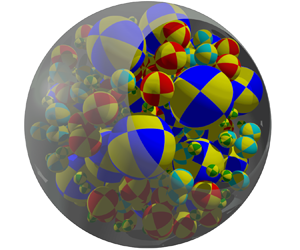Article contents
Impact of polydispersity and confinement on diffusion in hydrodynamically interacting colloidal suspensions
Published online by Cambridge University Press: 01 September 2021
Abstract

We present a computational study of the equilibrium dynamics of a polydisperse hard-sphere colloidal dispersion confined in a spherical cavity. We account for many-body hydrodynamic and lubrication interactions between particles and with the confining cavity utilizing our confined Stokesian dynamics model, expanded here for size polydispersity. We find that, even though the tendency of polydispersity to homogenize structure in a suspension is still present in confinement, strong correlations induced by the cavity resist homogenization. Although seemingly opposite, these two effects have a common driver, which is to maximize configurational entropy of particles in the cavity interior. These structural effects couple with the hydrodynamics to change the particle dynamics: polydispersity weakens lubrication effects near the cavity wall, allowing small (large) particles to diffuse faster (slower) than in a monodisperse suspension. As a small (large) particle gets farther from the wall, polydispersity weakens many-body hydrodynamic couplings, driving diffusivity up (down). While the local cage dynamics dominates short-time self-diffusion, long-time dynamics is also affected. In the concentrated regime, polydispersity and confinement combine to induce radial de-mixing into size-segregated populations. The cavity becomes the most influential ‘nearest neighbour’, setting the length scale of and dynamics within these radial domains. This intermediate length-scale caging makes the angular dynamics insensitive to polydispersity but leads to radial long-time mean-square displacement that changes qualitatively with volume composition. These results hold promise for explaining colloidal-scale physics implicated in the functioning of biological cells, and the engineering of non-living confined colloids where size de-mixing could be useful in the design of encapsulated micro-reactors and therapeutic vesicles.
- Type
- JFM Papers
- Information
- Copyright
- © The Author(s), 2021. Published by Cambridge University Press
References
REFERENCES
- 12
- Cited by



